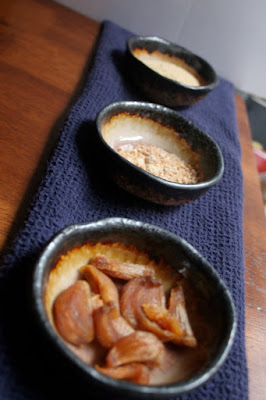Liquid Nitrogen or "I'm Going To Go Thaw This In The Freezer"
I didn't really think much about liquid nitrogen again. Puberty happened, and then I had to get a job. Having finally recovered from the realization that I will not be getting any taller and that I will likely have to work until I die, I found myself at the Astor Center, attending "Cold Cooking with Liquid Nitrogen" with Ideas In Food chefs Aki Kamozawa and H. Alexander Talbot.
They are talented chefs, writers and photographers, but they are also pretty darned good presenters.
The Experience
It was a great class. They gave us booze, did some lecture, performed a bunch of demonstrations. Alex and Aki are crazy smart, but totally approachable. As a teaching duo, they were very much themselves, and didn't try to be teaching robots. For example:
INT. ASTOR CENTER - EVENING
AKI and ALEX are giving a cooking demonstration. ALEX is demonstrating the use of acetate sheets to create cylinders out of egg yolks that have been cooked via sous-vide and then mixed with rendered prosciutto fat.
ALEX
Now, before you apply the egg yolk to the sheet make sure you use spray on some PAM release.
ALEX looks around, not seeing any PAM release.
ALEX (CONT'D)
Do you have the PAM release?
Without even waiting for the answer, Alex wisely leaves the room in search of PAM release.
AKI
So. While Alex gets that, I am going to continue with another demonstration. First, I'm going to have to refill the styrofoam chest with LNO.
AKI moves towards the LN dewar, carrying the styrofoam chest. It is on a tall table, making it a little awkward to refill the chest.
AKI
Alex hates it when I do this.
AKI completes the refill and proceeds with the demo. Alex enters victoriously with the PAM release.
ALEX
Found it!
ALEX furrows his brow.
ALEX (CONT'D)
Did you refill the LN?
What Can We Do With It
What follows are what I can recreate from my notes:
First and foremost, LN can be both a technique and an ingredient. It brings extreme cold to the party. Which in and of itself is pretty nifty because we don't really think about cold as much as we think about the use of heat in cooking. What can we use it for:
- Ice cream. There are two incredibly related reasons to use LN to make ice cream. The first reason is speed. LN is fucking cold. So cold it burns. So cold, you don't have to wait long for it to freeze things. Instant ice cream. Quicker you make it, the sooner it is enjoyed. Also, you are reducing the
amountsize of ice crystals that form. Ice crystals are not your friend, just ask this guy. Nitro-Freezing ice cream creates a better mouth-feel. - Shards. When you LN freeze vegetables, they become brittle. You can shatter them, like the aforementioned ball. For example, here is a picture of some shards of beet: (Credit: Josh Smith)

- Powders. Powder the unpowderable. Also, powder without the application of heat. Flavors will be raw. Instead of dehydrating then grinding ingredients, we can nitrofreeze then grind. Caramel powder. Raw Shrimp Powder (They added it to grits). I also have a note about powdering frozen spice blends, but I don't remember the value [Because it preserves volatile oils --Ed.] because of:
- Clouds. a.k.a. Frozen foams. For many of the fooderati, foams have jumped the shark. But do not fear the mighty foam. Freeze it instead. Aki and Alex made a mezcal cocktail with a yuzu cloud. My notes said: "frozen yuzu foam is ridiculous." (in a good way)
- Cryo-Blanching Vegetables. Nitrofreeze and thaw. They made nitro blanched beets and carrots with a green olive powder. The result is a texture between cooked and raw, with bright and clean flavors.
- LN tells you when it's done. Drop something into LN and it makes noise, like a bizarro-world fry-o-later. When it stops, it's frozen. Or for another analogy, it's like microwave popcorn. Speaking of fry-o-later, someone in the class suggested making a basket that could withstand the LN instead of having to fish out the food.
- Food Grade. General consensus from the class is that food grade LN is bunk, and that all LN is food grade.
- Powders. Make powders in smaller batches or you will get an inconsistent grind.
- Respect the LN. LN isn't all that different than hot oil. It can burn you. So can the stuff you prepare in it. Be especially careful if you are freezing alcohols.
- Allergies may apply. If you freeze an allergen in an LNO bath, you might want to be careful about reusing the bath. Even if not using allergens, it's a good idea to strain regularly.
- It ain't cheap. There is a startup cost that will make it unpalatable to the home chef. A 35L dewar can cost 800$. The nozzle can cost an additional 400$. Then to fill it can cost $2 a liter.
- Store and operate in a well ventilated space. Don't die.



Comments
Post a Comment